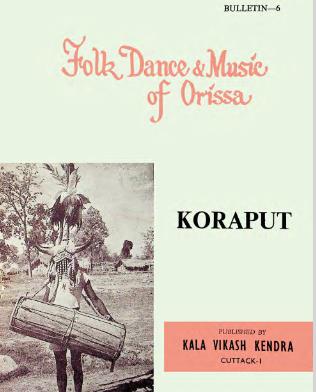In 1963, Biswanath Shaw published Folk Dance & Music of Orissa – Koraput, a seminal work that serves as a vital exploration of the artistic expressions and cultural heritage of the Koraput district in Odisha. This essay not only highlights the various folk dances and musical traditions but also provides a comprehensive view of the intricate relationship between these art forms and the tribal communities that cultivate them. Shaw’s insights are invaluable for anyone keen on understanding the unique blend of culture, art, and social dynamics that define Koraput.
Koraput is home to a multitude of indigenous tribes, each contributing to a rich tapestry of folk traditions that are deeply interwoven with the region’s history and environment. Shaw’s work captures the essence of these traditions, documenting a variety of folk dances such as the Goti Pua and Raut Nacha, which are performed during festivals and significant community gatherings. These dances are not mere performances; they are vital expressions of identity and continuity, preserving the histories and narratives of the tribes.
Through vibrant descriptions, Shaw immerses readers in the visual and auditory landscapes of Koraput. He illustrates how the lively movements of dancers, adorned in traditional attire, create a colorful spectacle that echoes the rhythms of tribal music played on local instruments such as the dhol and madal. The marriage of dance and music in these performances encapsulates the spirit of celebration and cultural pride among the tribes.
A significant aspect of Shaw’s analysis lies in the exploration of folklore within these artistic expressions. The songs often incorporate themes of mythology, daily life, and nature, allowing the community to communicate shared values and experiences. He emphasizes how these narratives are a storytelling medium, preserving the wisdom of elders and passing down knowledge through generations. In this way, dances and songs serve as historical documents, reflecting the ethos of the tribes.
Shaw draws attention to the role of women in these performances, particularly in the Dandia and Jhumar dances, illuminating their significance not only as artists but as custodians of tradition. Women’s participation showcases empowerment within the cultural sphere, where they play a pivotal role in keeping artistic legacies alive.
Music in Koraput transcends mere entertainment; it is a vital element of social cohesion. Shaw articulates how tribal music is integral to communal rituals, festivals, and celebrations. The rhythms foster unity, drawing people together in shared experiences that reinforce the bonds of community. He delves into the emotional and spiritual dimensions of the music, demonstrating how it serves as a conduit for expressing joy, sorrow, and reverence.
Moreover, Shaw highlights the instruments unique to Koraput, such as the flute and ghungroo, which contribute to the distinctive soundscapes of tribal music. Each instrument is not only a tool for creating sound but also a symbol of cultural identity, deeply rooted in the community’s lifestyle and beliefs.
Though Folk Dance & Music of Orissa – Koraput is an exploration of traditional practices, Shaw does not overlook the challenges posed by modernization. He thoughtfully addresses how globalization and urbanization threaten the sustainability of these folk art forms. His work calls for a concerted effort to preserve tribal music and dance, encouraging both local engagement and scholarly interest to ensure that these vibrant traditions continue to thrive amidst changing times.
In summary, Folk Dance & Music of Orissa – Koraput by Biswanath Shaw is an essential text that celebrates the rich artistic legacy of the Koraput district. Through meticulous documentation and insightful analysis, Shaw offers a window into the lives, beliefs, and creativity of Odisha’s tribal populations. This book serves as a reminder of the importance of cultural preservation and the need to honor the narratives encapsulated in folk dances and music, as they are vital threads in the fabric of Odisha’s identity. ️
Books Info
| Books name | Folk Dance & Music Of Orissa – Koraput |
| Author | Biswanath Shaw |
| No Of pages | 54 |
| Publisher | Kala Vikash Kendra |
| Publication | 1963 |
| Printed At | Rashtrashikshya Co-op Press |
| Distributor | NA |

